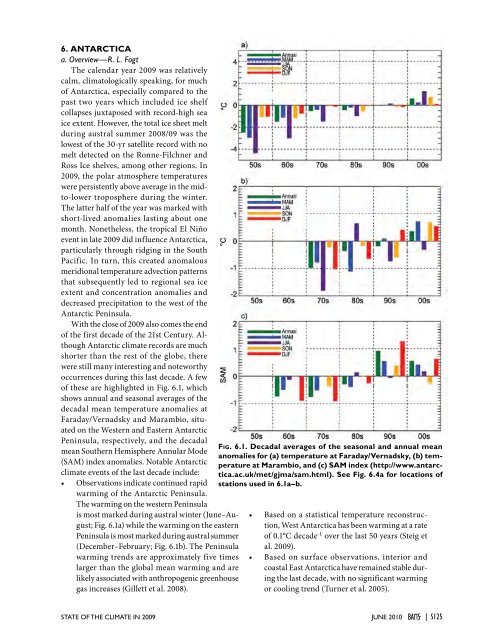Create successful ePaper yourself
Turn your PDF publications into a flip-book with our unique Google optimized e-Paper software.
6. ANTARCTICAa. Overview—R. L. FogtThe calendar year <strong>2009</strong> was relativelycalm, climatologically speaking, for muchof Antarctica, especially compared to thepast two years which included ice shelfcollapses juxtaposed with record-high seaice extent. However, the total ice sheet meltduring austral summer 2008/09 was thelowest of the 30-yr satellite record with nomelt detected on the Ronne-Filchner andRoss Ice shelves, among other regions. In<strong>2009</strong>, the polar atmosphere temperatureswere persistently above average in the midto-lowertroposphere during the winter.The latter half of the year was marked withshort-lived anomalies lasting about onemonth. Nonetheless, the tropical El Niñoevent in late <strong>2009</strong> did influence Antarctica,particularly through ridging in the SouthPacific. In turn, this created anomalousmeridional temperature advection patternsthat subsequently led to regional sea iceextent and concentration anomalies anddecreased precipitation to the west of theAntarctic Peninsula.With the close of <strong>2009</strong> also comes the endof the first decade of the 21st Century. AlthoughAntarctic climate records are muchshorter than the rest of the globe, therewere still many interesting and noteworthyoccurrences during this last decade. A fewof these are highlighted in Fig. 6.1, whichshows annual and seasonal averages of thedecadal mean temperature anomalies atFaraday/Vernadsky and Marambio, situatedon the Western and Eastern AntarcticPeninsula, respectively, and the decadalmean Southern Hemisphere Annular Mode(SAM) index anomalies. Notable Antarcticclimate events of the last decade include:• Observations indicate continued rapidwarming of the Antarctic Peninsula.The warming on the western Peninsulais most marked during austral winter (June–August;Fig. 6.1a) while the warming on the easternPeninsula is most marked during austral summer(December–February; Fig. 6.1b). The Peninsulawarming trends are approximately five timeslarger than the global mean warming and arelikely associated with anthropogenic greenhousegas increases (Gillett et al. 2008).Fig. 6.1. Decadal averages of the seasonal and annual meananomalies for (a) temperature at Faraday/Vernadsky, (b) temperatureat Marambio, and (c) SAM index (http://www.antarctica.ac.uk/met/gjma/sam.html).See Fig. 6.4a for locations ofstations used in 6.1a–b.• Based on a statistical temperature reconstruction,West Antarctica has been warming at a rateof 0.1°C decade -1 over the last 50 years (Steig etal. <strong>2009</strong>).• Based on surface observations, interior andcoastal East Antarctica have remained stable duringthe last decade, with no significant warmingor cooling trend (Turner et al. 2005).<strong>STATE</strong> <strong>OF</strong> <strong>THE</strong> <strong>CLIMATE</strong> <strong>IN</strong> <strong>2009</strong> juNE 2010 |S125
















